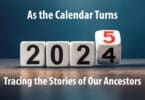When you have a brick wall ancestor, it is frustrating. If the brick wall person in question only appeared in pre-1850 census records and had a common surname, it gets even more challenging to discover their origins. It may seem like you will never break through that wall, and that you will be better just giving up and working on another family line. But, don’t give up on that brick wall ancestor just yet. There is a little known genealogical technique that may help you break through to the other side of the wall. It’s called cluster research, and here’s how it’s done.
The first thing to know about cluster research is that it takes some time to do properly, so you have to commit to it, and be patient with it. It really is a worthwhile pursuit, and often is the only thing that will produce results when searching for the origins of the brick wall ancestor. Cluster research is also known as the FAN Technique, because it involves “fanning out” in the people you research, looking for anyone with a connection to your ancestor. This means you look for and research anyone you know was associated with them or might have been because people often left records mentioning people they knew. Answers in genealogy don’t always come from researching only the family.
Professional genealogists use this technique because it is effective. It can identify your ancestor from among a community of men or women of similar names, it can identify the place of origin of an ancestor who immigrated elsewhere, and it can identify people who are possible relatives and close friends or business associates of your brick wall ancestor. This is all valuable information in breaking through that wall.
The first thing you need to do is gather all of the information you have about your brick wall ancestor, to determine where you should start looking for clues among their likely neighbors and associates. Let’s say you have an ancestor who you know served in the War of 1812 in Twiggs County, Georgia, and you know he died in 1855 in Tallapoosa County, Alabama. He appears in one post-1850 census, with no wife and four grown children. Pre-1850 census records indicate he did have a wife and had other children besides the ones listed in the 1850 census. He has a relatively common last name, but only a moderately common first name for the time. You have no idea who his wife or parents were and have used every avenue of research on him personally, and his children, that you can possibly do, and Twiggs County has a burned courthouse, so any records that might have proven his origins are no longer available. This is a perfect brick wall ancestor for the cluster research technique.
Research his regiment in the War of 1812. Who was in it? Did anyone in his regiment share his last name? Was there anyone in it with the same first and last name? People often enlisted in military engagements with relatives, especially if most members of a regiment came from the same town. These are people you should research thoroughly, just like you did with your brick wall ancestor. You may discover evidence that they are close relatives of the brick wall person. You can almost guarantee a relationship if they lived in the same town at the time of the war, and had children with similar first and/or middle names. You may even find documentary evidence to prove it. Look for parents and grandparents of these new people, and try to connect your brick wall ancestor to the family.
If there is no one in their regiment with the same surname, try placing others in the regiment in your ancestor’s community. Using census records, see if any of them lived in his community and if they were neighbors. In past centuries, people usually had close ties with their neighbors. Intermarriages happened between children of neighbors, and they relied on each other for many things. Just keep researching the regiment members, starting with the ones who lived closest to your ancestor, looking for a connection. If your ancestor moved to another town or state after the war, see if any men in his regiment moved to the same place. Ending up in the same community after immigrating often indicates a close, personal relationship, which should be explored to find clues to your ancestor’s life and origins.
Once you’ve exhausted this ancestor’s old regiment connections (or, if your ancestor never served in the military), begin researching both the first community you find him in and the other communities you know he lived in. Investigate not only his close neighbors but business owners in town. Chances are high your ancestor had dealings with the local business people at least every now and then. With thorough research of all of these people, just like you would do with an ancestor, you have a much better chance of coming up with that piece of gold you’ve been searching for, in the form of a document mentioning your ancestor that you would never have found if you only researched known relatives and descendants. It may be a document that mentions your ancestor’s origins and parents outright, gives the name of an unknown wife (or the unknown maiden name of a wife whose first name is known), or may simply give you a clue as to another avenue of research to pursue, such as a new town to investigate or new people to look into that had connections to your ancestor.
You can use this technique to identify your ancestor from a town of men with the same name by comparing all the same-named entries across census records and looking into neighbors and associates to tease your ancestor out from the same-named crowd. Just use your logic, math, and other genealogical skills to their fullest, finest capacity and your efforts will yield results nine times out of ten with this technique. Yes, cluster research takes time, but in breaking down genealogical brick walls, it is so worth it.






